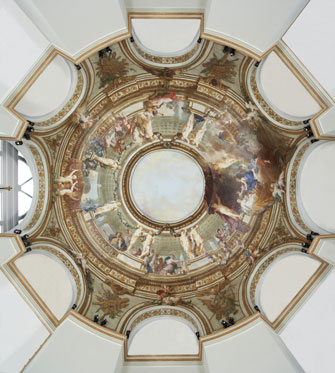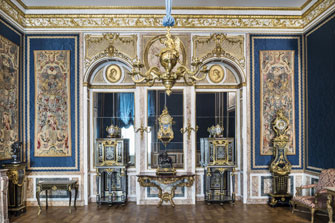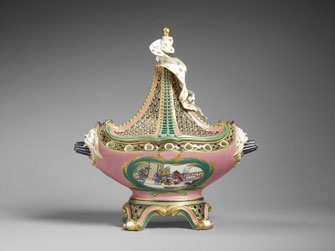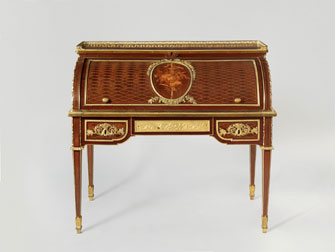Ancien Régime’s Good Taste
Thrones at Louvre Once Again

A cupola painted by Antoine François Callet for the pavilion of the Palais Bourbon, now installed in the Louvre’s new 18th-century decorative arts rooms.
Following a 10-year restoration, the Louvre has finally reopened the rooms in the Sully Wing devoted to 18th-century decorative arts. The collection – which includes royal furniture, decorative bronzes, tapestries, rugs, gold and silver ware, porcelain, jewelry, scientific instruments, early clocks and pocket watches, mirrors and glassware – illustrates the excellence and refinement of French taste and artistic skill during this prolific period. It is a true feast for the eyes.
The renowned interior decorator Jacques Garcia, a specialist in the 18th century, has produced a beguiling scenography that pays scrupulous attention to historical accuracy. The approximately 30 rooms, including 14 period rooms, cover 20,000 square feet. The sequence offers a vivid illustration of the Age of Enlightenment, beginning with the reign of Louis XIV, continuing through Louis XV and ending with Louis XVI and Marie Antoinette.
After Louis XIV moved the French court to Versailles in 1672, the Louvre became the home of the Manufactures Royales and artisans’ workshops. Craftsmen were recruited from all over Europe – glassmakers from Venice, cabinetmakers from Flanders and Germany, stonecutters from Florence and weavers from Brussels and Antwerp. These master tradesmen laid the foundation for the tradition of French luxury craftsmanship that set the tone for the following century.
The tradition of granting premises in the Louvre to craftsmen was maintained from the late 17th century until the Revolution. The cabinetmaker Andre-Charles Boulle had his workshop there, as did goldsmiths, painters and sculptors. The palace became a hub of creative activity in all the arts and crafts.
The chronological sequence of the collection at the Louvre provides an overview of the evolution of French taste during the 18th century. The period rooms show the works

Room from the Hôtel Le Bas de Montargis © 2014 Musée du Louvre, dist. RMN-GP/Olivier Ouadah
in context, giving the visitor a taste of the refinement and savoir-vivre of the ruling classes of the times.
It’s delightful to linger before such fantastic treasures as a jade bowl with a bloodstone base once owned by Marie Antoinette. The bowl is set on a finely carved gilt-bronze mount decorated with scrolls, friezes of myrtle leaves and serrated fleurons. Two leaning roosters carry the bowl on their backs while two winged cupids perch on the birds’ heads, peering into its depths.
Vitrines of small items such as snuffboxes and pocket watches embellished with cut stones, finely carved motifs or painted views stand out with their exquisite detail.
A very fine gold coffee grinder in three colors of gold, steel and ivory that once belonged to Madame de Pompadour was made by Jean Ducrollay, one of the leading goldsmiths and

Madame de Pompadour’s potpourri from the Hôtel d’Évreux, made at the Sèvres Manufacture Royale de Porcelaine, 1760-1761. © Musée du Louvre, dist. RMN-GP/Thierry Ollivier
jewelers in Paris during the reign of Louis XV.
One of the star period rooms is the Hotel Dangé-Villemare drawing room. With its vivid turquoise paneling, it is a spectacular example of fine craftsmanship from the reign of Louis

Marie-Antoinette’s desk, made by Jean-Henri Riesener in 1784. © 2010 RMN/Martine Beck-Coppola
XV. In another room, Marie Antoinette’s desk takes center stage.
The catalog for the inauguration of these newly restored rooms contains detailed explanations and excellent photographs of the more than 2,000 works on show. In sum total, they are magnificent, a testament to the golden age of absolute monarchy. But they are also, perhaps, a little chilling, a resplendent reminder of an age when wealth was concentrated in the hands of a tiny elite while most people barely survived – an age cut short by the guillotine. Today’s one percent might ruminate on that (but surely won’t).
Musée du Louvre: Hall Napoléon. Métro: Palais-Royal-Musée du Louvre. Tel.: 01 40 20 53 17. Open Wednesday-Monday, 9am-6pm (until 9.45pm on Wednesday and Friday). Closed Tuesday, December 25 and January 1. Admission: €12. www.louvre.fr
Click here to read all of this week’s new articles on the Paris Update home page.
Reader Reaction: Click here to respond to this article (your response may be published on this page and is subject to editing).
Support Paris Update by ordering books from Paris Update’s Amazon store at no extra cost. Click on your preferred Amazon location: U.K., France, U.S.
© 2014 Paris Update
Favorite